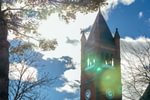

In a planetarium, you expect to look up and see stars. But at Gettysburg, you can also zoom in on different organs inside the body, analyze geological information, and look at the universe in the past, present, and future. Want to see what the sky looked like this month in 1832, the year the College was founded? Now you can.
Hatter Planetarium, located on the first floor of Masters Hall, was renovated this past summer as a result of a $150,000 grant from The George I. Alden Trust and private donations, including a gift from Richard Ellis ’52. The new space doubles as a classroom, complete with a full-dome digital projector and technology that can be used for a variety of disciplines.
“I was only too happy to help fund this project,” said Ellis, a Pittsburgh native who comes from a family of scientists and engineers. “No matter what their major, this adds a dimension and gives students another learning opportunity.”
Hatter Planetarium was originally constructed in 1966 with a 30-foot dome and optical-mechanical projector. As part of the renovation, a digital Spitz SciDome projector was installed, enabling photo-realistic representations of the sky that weren’t possible with the original technology.
 With the addition of a full-dome projector, the planetarium now serves as a functional classroom space for introduction to astronomy classes. The space was also renovated with an eye toward creating an active learning environment; new technology includes flat-field projectors, a surround sound system, a document camera, a receiver for student response devices, and 360° of whiteboards surrounding the room—with students sitting in the middle of it all.
With the addition of a full-dome projector, the planetarium now serves as a functional classroom space for introduction to astronomy classes. The space was also renovated with an eye toward creating an active learning environment; new technology includes flat-field projectors, a surround sound system, a document camera, a receiver for student response devices, and 360° of whiteboards surrounding the room—with students sitting in the middle of it all.

“Hatter is now literally a student-centered learning environment,” said physics and astronomy Prof. Jacquelynne Milingo. “The specialized software for the full-dome projector provides opportunities for students and faculty in astronomy, physics, biology, health sciences, art, film studies, environmental and geographical information studies, geology, and any topic that would benefit from a visually immersive curved-field environment.”
A grant from The Johnson Center for Creative Teaching & Learning provided faculty with the support to complete training on the use of the new system. Its capabilities are vast and provide promise for future coursework—the sky is no longer the limit. For example, there are full-dome digital theater shows that explore the significance of archeo-astronomical sites such as Stonehenge and connections between astronomical events and US history, such as Abraham Lincoln’s use of the lunar cycle as evidence during a murder trial.
“The possibilities are endless for developing new first-year seminars and creative interdisciplinary approaches,” said Milingo.
The impact of the renovation also reaches the greater community of Gettysburg and surrounding areas. The planetarium provides field trip opportunities for local schools and offers a series of seasonal shows that are open to the public. Since September, approximately 350 people have visited the new space.

“It’s a great benefit to have facilities like this that we use for classes and then can open up for the public,” said Ian Clarke, the planetarium’s director and an English professor. “It brings people into the college—teachers for example—who can then go out and germinate knowledge. It also enables our students to get involved in public outreach work; it’s a great experience for our students to be able to offer public shows.”
Learn more about Hatter Planetarium and view the public show schedule, which is updated monthly.


